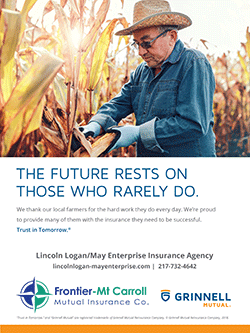|
 About the program: The ARC Program is an income support program
that provides payments when actual crop revenue declines below a
specified guarantee level. The PLC Program provides payments
when the effective price for a covered commodity falls below
its’ effective reference price. About the program: The ARC Program is an income support program
that provides payments when actual crop revenue declines below a
specified guarantee level. The PLC Program provides payments
when the effective price for a covered commodity falls below
its’ effective reference price.
Illinois producers are strongly encouraged to contact their
local FSA county office to start the election and enrollment
process early. County offices cannot get everyone in at once –
so while you are thinking about it, stop in your county office
and elect/enroll and certify your yields now.
Signup is also ongoing for the Market Facilitation Program (MFP),
a U.S. Department of Agriculture (USDA) program to assist
farmers who continue to suffer from damages because of
unjustified trade retaliation from foreign nations. Through MFP,
USDA will provide up to $14.5 billion in direct payments to
impacted producers, part of a broader trade relief package
announced in late July. The sign-up period runs through Dec. 6,
2019.
MFP payments will be made to producers of certain non-specialty
and specialty crops as well as dairy and hog producers.
The Dairy Margin Coverage Program (DMC) 2020 Enrollment ends
Dec. 13, 2019.
Please try to visit your local county FSA office sooner than
later to be sure you don't miss any of these pertinent program
deadlines.
Here's wishing you a Happy, Healthy, Safe Thanksgiving!
William J. Graff
State Executive Director

USDA Opens 2020 Enrollment for Dairy Margin
Coverage Program- Ends Dec. 13, 2019
Dairy producers can now enroll in the Dairy Margin Coverage (DMC)
for calendar year 2020. USDA’s Farm Service Agency (FSA) opened
signup for the program that helps producers manage economic risk
brought on by milk price and feed cost disparities.
The DMC program offers reasonably priced protection to dairy
producers when the difference between the all-milk price and the
average feed cost (the margin) falls below a certain dollar
amount selected by the producer. The deadline to enroll in DMC
for 2020 is Dec. 13, 2019.
Agriculture Risk Coverage and Price Loss
Coverage programs
2019 enrollment opened September 3, 2019 and runs through
March 15, 2020.
About the program: The ARC Program is an income support program
that provides payments when actual crop revenue declines below a
specified guarantee level. The PLC Program provides payments
when the effective price for a covered commodity falls below
its’ effective reference price.
Producers are strongly encouraged to contact their local FSA
county office to start the election and enrollment process
early. County offices cannot get everyone in at once – so while
you are thinking about it, stop in your county office and
elect/enroll and certify your yields now.
You can make a program election now, and then make a
change to that election anytime between now and the deadline,
March 15, 2020.
The election made for 2019 will also be
effective for 2020.
You will have the opportunity to reelect to a different
program election, in each year from 2021-2023.
Elections of ARC-CO or PLC are made on a covered
commodity by covered commodity basis.
If ARC-IC is elected, all covered commodity base acres on
the farm have elected ARC-IC.
Failure to make an election for 2019 will result in the
program election for 2018 being in effect for 2019 and 2020, for
all covered commodities.
The failure of producers on a farm to make a unanimous
election for 2019 will result in the farm not being eligible for
2019 payments.
Farm owners have a one-time opportunity to update the
farm PLC yield starting in 2020, on a commodity-by-commodity
basis.
The owner will certify to the yield.
Production evidence is not required, unless requested by FSA.
-
Yields may be provided by the operator or the owner, but it
is the owner’s decision whether or not to update the yield
(At least one owner’s signature is required).
-
Use of RMA production for yield data is encouraged, when
certifying to yields for yield
-
update purposes.
-
The updated yield for the farm is equal to 90% of each
covered commodity’s 2013-2017 average yield, multiplied by a
National Yield factor.
If the farm owner and the producer visit
the office together, FSA can process the ARCPLC election and
enrollment, as well as update the owner’s yield information, all
in the same visit. The Farm yield update only requires ONE
owner’s signature.
The opportunity to update the Farm’s yield(s) is
voluntary. The yield update period ends September 30, 2020.
Covered commodities include wheat, oats, barley, corn,
grain sorghum, rice long grain, rice medium grain, soybeans,
sunflower seed, rapeseed, canola, safflower seed, flaxseed,
mustard seed, crambe, sesame seed, dry peas, lentils, small
chickpeas, large chickpeas, peanuts, and seed cotton.

2020 enrollment period began October
2019, and ends June 30, 2020.
Under the 2018 Farm Bill, the producer on a
farm with 10 base acres or less may remain eligible for payment,
if the total base acres from all enrolled farms in which the
producer has an interest is greater than 10 base acres.
SDA farmer or rancher, limited resource farmer or rancher,
beginning farmer, or veteran
Producer, remain eligible for ARCPLC payments on farms having 10
acres or less base acres.
FSA Encourages Farmers and Ranchers to Vote
in County Committee Elections
The 2019 Farm Service Agency County Committee Elections begin on
November 4, 2019, when ballots will be mailed to eligible
voters. The deadline to return the ballots to local FSA offices
is December 2, 2019.
County committee members are an important component of the
operations of FSA and provide a link between the agricultural
community and USDA. Farmers and ranchers elected to county
committees help deliver FSA programs at the local level,
applying their knowledge and judgment to make decisions on
commodity price support programs; conservation programs;
incentive indemnity and disaster programs for some commodities;
emergency programs and eligibility. FSA committees operate
within official regulations designed to carry out federal laws.
To be an eligible voter, farmers and ranchers must participate
or cooperate in an FSA program. A person who is not of legal
voting age but supervises and conducts the farming operations of
an entire farm, may also be eligible to vote.
It is important that every eligible producer participate in
these elections because FSA county committees are a link between
the agricultural community and USDA.
To be eligible to vote in the elections, a person must:
Meet requirement one (see explanation below) or meet requirement
two, and requirement three (see explanation below).
Requirement One: Be of legal voting age and have an
interest in a farm or ranch as either: an individual who meets
one or more of the following; (a) is eligible to vote in one’s
own right, (b) is a partner of a general partnership, (c) is a
member of a joint venture OR an authorized representative of a
legal entity, such as: (a) a corporation, estate, trust, limited
partnership or other business enterprise, excluding general
partnership and joint ventures or (b) a state, political
subdivision of a state or any state agency (only the designated
representative may cast a vote for the entity).
Requirement Two: Not of legal voting age but supervises
and conducts the farming operations of an entire farm.
Requirement Three: Participates or cooperates in an FSA
program that is provided by law.
For more information on eligibility to serve on FSA county
committees, visit:
www.fsa.usda.gov/elections.
Marketing Assistance Available for 2019
Crops
The 2018 Farm Bill extends loan authority through 2023 for
Marketing Assistance Loans (MALs) and Loan Deficiency Payments (LDPs).
MALs provide financing and marketing assistance for commodities
such as wheat, feed grains, soybeans and other oilseeds, pulse
crops, rice, wool and honey. MALs provide producers interim
financing after harvest to help them meet cash flow needs
without having to sell their commodities when market prices are
typically at harvest-time lows.
A producer who is eligible to obtain a MAL, but agrees to forgo
the loan, may obtain an LDP if such a payment is available.
To be eligible for a MAL, producers must have a beneficial
interest in the commodity, in addition to other requirements. A
producer retains beneficial interest when control of and title
to the commodity is maintained.
Farm Reconstitutions and Farm Transfers
When changes in farm ownership or operation take place, a farm
reconstitution may be necessary. The reconstitution — or recon —
is the process of combining or dividing farms or tracts of land
based on the farming operation.
In addition, a change in farm ownership or operation may
necessitate a request for a new administrative county. The
transfer request may be initiated due to a change in operation
of land, a farm combination with other farms operated by the
same person, a change in dwelling of the operator, a change
occurs that makes another County Office more accessible, a
County Office closure or reduced hours of operation, or if
another County Office is significantly more convenient for the
producer.
To be effective for the current Fiscal Year (FY), farm
reconstitutions and farm transfers must be requested by August 1
of the FY for farms subject to the Agriculture Risk Coverage
(ARC) and Price Loss Coverage (PLC) program.
A reconstitution is considered to be requested when all:
-
of the required signatures are on FSA-155
-
other applicable documentation, such as proof of ownership,
is submitted.
[to top of second column] |

A farm transfer is considered to be requested when all:
Total Conservation Reserve Program (CRP) and
non-ARC/PLC farms may be reconstituted at any time.
For more information and assistance, please contact your local USDA
service center. To find your local USDA service center, visit
farmers.gov/service-center-locator.
Supervised Credit
Farm Service Agency (FSA) Farm Loan programs are considered
supervised credit. Unlike loans from a commercial lender, FSA loans
are intended to be temporary in nature. Therefore, it is our goal to
help you graduate to commercial credit, and our farm loan staff is
available to help borrowers through training and credit counseling.
The FSA team will help borrowers identify their goals to ensure
financial success. Through this process, FSA staff will advise
borrowers in developing strategies and a plan to meet your
operation’s goals and graduate to commercial credit. Ultimately, the
borrower is responsible for the success of the farming operation,
but FSA’s staff will help in an advisory role to provide the tools
necessary to help you achieve your operational goals and manage your
finances.
Farm Storage Facility Loans
FSA’s Farm Storage Facility Loan (FSFL) program provides
low-interest financing to producers to build or upgrade storage
facilities and to purchase portable (new or used) structures,
equipment and storage and handling trucks.
The low-interest funds can be used to build or upgrade permanent
facilities to store commodities. Eligible commodities include corn,
grain sorghum, rice, soybeans, oats, peanuts, wheat, barley, minor
oilseeds harvested as whole grain, pulse crops (lentils, chickpeas
and dry peas), hay, honey, renewable biomass, fruits, nuts and
vegetables for cold storage facilities, floriculture, hops, maple
sap, rye, milk, cheese, butter, yogurt, meat and poultry
(unprocessed), eggs, and aquaculture (excluding systems that
maintain live animals through uptake and discharge of water).
Qualified facilities include grain bins, hay barns and cold storage
facilities for eligible commodities.
Loans up to $50,000 can be secured by a promissory note/security
agreement and loans between $50,000 and $100,000 may require
additional security. Loans exceeding $100,000 require additional
security.
Producers do not need to demonstrate the lack of commercial credit
availability to apply. The loans are designed to assist a diverse
range of farming operations, including small and mid-sized
businesses, new farmers, operations supplying local food and farmers
markets, non-traditional farm products, and underserved producers.
To learn more about the FSA Farm Storage Facility Loan, visit
www.fsa.usda.gov/pricesupport or contact your local FSA county
office. To find your local FSA county office, visit
http://offices.usda.gov.
Maintaining the Quality of Farm-Stored Loan
Grain
Bins are ideally designed to hold a level volume of grain. When bins
are overfilled and grain is heaped up, airflow is hindered and the
chance of spoilage increases.
Producers who take out marketing assistance loans and use the
farm-stored grain as collateral should remember that they are
responsible for maintaining the quality of the grain through the
term of the loan.

Unauthorized Disposition of Grain
If loan grain has been disposed of through feeding, selling or any
other form of disposal without prior written authorization from the
county office staff, it is considered unauthorized disposition. The
financial penalties for unauthorized dispositions are severe and a
producer’s name will be placed on a loan violation list for a
two-year period. Always call before you haul any grain under loan.
Authorization Required for Incidental Grazing of
CRP Acres
In certain situations, landowners and operators may need to graze a
field containing Conservation Reserve Program (CRP) continuous
practices such as grass waterways (CP8A), contour grass strips
(CP15A); filter strips (CP21); quail and upland bird habitat buffers
(CP33), denitrifying bioreactor on filter strips (CP21B), or
saturated filter strips (CP21S). FSA must first authorize the
incidental grazing on CRP in a field intended to be gleaned.
Grazing is incidental to the gleaning of the crop residue in a
field, or before the harvest of a small grain and occurs after the
harvest of crops from within the surrounding field, or during the
dormant period of a small grain intended for harvest. The grazing
cannot occur during the primary nesting season, which for Illinois
is April 15 through August 1. In addition, grazing can only occur if
the approved cover for that practice has been established and the
grazing will not adversely impact the purpose or performance of the
practice.
All livestock shall be removed from CRP acreage no later than two
months after incidental grazing begins. CRP participants utilizing
incidental grazing will have a payment reduction for the acreage
being grazed. Participants are also responsible, at their own
expense, to reestablish a cover destroyed or damaged as a result of
the incidental grazing.
If the acreage to be grazed is separated from the surrounding
cropland by a fence, the CRP acreage shall not be grazed.
USDA Microloans Help Farmers Purchase Farmland
and Improve Property
Producers, Including Beginning and Underserved Farmers, Have a
New Option to Gain Access to Land
The U.S. Department of Agriculture (USDA) is offering farm ownership
microloans, creating a new financing avenue for farmers to buy and
improve property. These microloans are especially helpful to
beginning or underserved farmers, U.S. veterans looking for a career
in farming, and those who have small and mid-sized farming
operations.
The microloan program has been hugely successful, providing more
than 16,800 low-interest loans, totaling over $373 million to
producers across the country. Microloans have helped farmers and
ranchers with operating costs, such as feed, fertilizer, tools,
fencing, equipment, and living expenses since 2013. Seventy percent
of loans have gone to new farmers.
Now, microloans will be available to also help with farm land and
building purchases, and soil and water conservation improvements.
FSA designed the expanded program to simplify the application
process, expand eligibility requirements and expedite smaller real
estate loans to help farmers strengthen their operations. Microloans
provide up to $50,000 to qualified producers and can be issued to
the applicant directly from the USDA Farm Service Agency (FSA).
To learn more about the FSA microloan program visit
www.fsa.usda.gov/
microloans, or contact your local FSA office.
Breaking New Ground
Agricultural producers are reminded to consult with FSA and NRCS
before breaking out new ground for production purposes as doing so
without prior authorization may put a producer’s federal farm
program benefits in jeopardy. This is especially true for land that
must meet Highly Erodible Land (HEL) and Wetland Conservation (WC)
provisions.

Producers with HEL determined soils are required to apply tillage,
crop residue and rotational requirements as specified in their
conservation plan.
Producers should notify FSA as a first point of contact prior to
conducting land clearing or drainage type projects to ensure the
proposed actions meet compliance criteria such as clearing any trees
to create new cropland, then these areas will need to be reviewed to
ensure such work will not risk your eligibility for benefits.
Landowners and operators complete the form AD-1026 - Highly Erodible
Land Conservation (HELC) and Wetland Conservation (WC) Certification
to identify the proposed action and allow FSA to determine whether a
referral to Natural Resources Conservation Service (NRCS) for
further review is necessary.
Illinois Department of Transportation Explore
Use of Living Snow Fences
Do you live or farm near a state route or interstate? Does winter
make travel difficult? The Illinois Department of Transportation is
exploring the use of living snow fences to reduce impaired travel
from blowing and accumulating snow. To learn more go to
farmweeknow.com.
November Interest Rates and Important Dates to
Remember
_small.png)
Illinois Farm Service Agency
3500 Wabash Ave.
Springfield, IL 62711
Phone: 217-241-6600
Fax: 855-800-1760
www.fsa.usda.gov/il
State Executive Director:
William J. Graff
State Committee:
James Reed-Chairperson
Melanie DeSutter-Member
Kirk Liefer-Member
George Obernagel III-Member
Troy Uphoff-Member
Administrative Officer:
Dan Puccetti
Division Chiefs:
Vicki Donaldson
John Gehrke
Natalie Prince
Randy Tillman
To find contact information for your local office go to
www.fsa.usda.gov/il
Check out
https://www.farmers.gov/ for information about ALL the programs
available through your local USDA Service Center FSA and NRCS
offices, including county office locations, agriculture statistics,
loan interest rates and much more!
Learn about Risk Management Agency's crop insurance programs at
https://cropinsurance101.org/
USDA is an equal opportunity provider, employer and lender. To file
a complaint of discrimination, write: USDA, Office of the Assistant
Secretary for Civil Rights, Office of Adjudication, 1400
Independence Ave., SW, Washington, DC 20250-9410 or call (866)
632-9992 (Toll-free Customer Service), (800) 877-8339 (Local or
Federal relay), (866) 377-8642 (Relay voice users). |